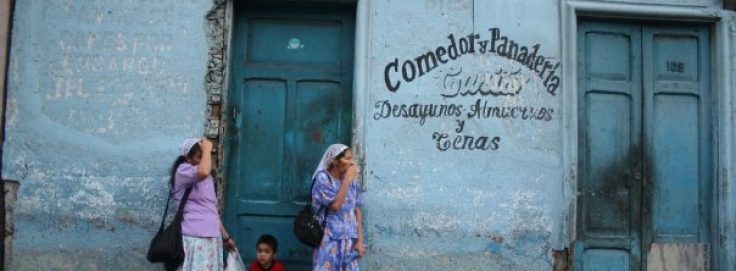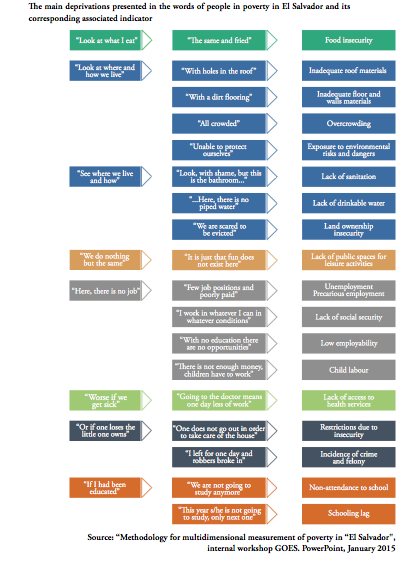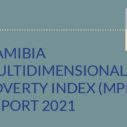
Search
Defining MPI dimensions through participation: the case of El Salvador

In late 2009, El Salvador began the process of creating a multidimensional poverty measure. A central issue was the definition of the constitutive dimensions of the Multidimensional Poverty Index.
How should the dimensions that would best reflect what Salvadorian society considers as the core aspects of poverty be chosen? The United Nations Development Programme (UNDP) of El Salvador and TECHO organisation, with the support of the Technical and Planning Secretariat (STPP for its acronym in Spanish) of the Presidency of the Republic held a series of 23 focus groups in different areas of the country where people living under poverty conditions were asked what poverty meant for them, the dimensions that composed it and the strategies that they used in order to survive.
The analysis of the focus groups identified the main deprivations from the people’s perspective. Five dimensions and twenty indicators that are currently part of the multidimensional measurement of poverty were established. The series of focus groups determined the definition of the dimensions and indicators of the Multidimensional Poverty Index [1].
Choosing dimensions
The process of defining the dimensions of the Multidimensional Poverty Index of El Salvador (MPI-ES) began with a discussion on the topic by the Advisory Board chaired by the STPP of El Salvador and the UNDP where, on the basis of their experience, a series of dimensions or desirable components were listed for a measurement of the multidimensional poverty. A second exercise was to identify the dimensions generally proposed by the literature on poverty, considering reports such as the ones of the Sen-Stiglitz-Fitoussi Commission[2] and already proven indicators, such as the ones contained in the Millennium Development Goals.
So far, this has been the first and only participatory process to define the dimensions of a multidimensional poverty index conducted by a country
The Board arrived at the consensus that it was necessary to do a first exercise with the data available in the country. Bearing this in mind, existing surveys were analysed to identify which of the proposed indicators were measurable. The Household Survey of Multiple Purposes (EHPM for its acronym in Spanish), was the main source of data, because it was the annual survey with the highest level of representation. However, this survey had good information only for three dimensions: the labour market, housing materials and basic services, and education, leaving aside other important topics such as health or security. There was a gap between the desired components for an MPI beyond these three basic dimensions and what household surveys could deliver in terms of data.
This was an information gap that could only be remedied by changing and adding questions to the EHPM, for which there were resources and political will. The question that arose was, what dimensions had to be included in the survey? At this point it was decided to promote a participative process with the population living under poverty.
Qualitative study
Between August and September 2012, UNDP, together with the TECHO organisation, conducted a series of 23 focus groups or tables of consultation with residents of 20 communities living in poverty. Of the 23 focus groups, in 20 participants were adults (18 and over) and the other three were special groups: children, community leaders and women. In total, about 250 people collaborated.
The identification of the areas was made from the Map of Poverty and Social Exclusion, a tool that was used to define the settlements and squatter homes that were more vulnerable.
The decision was made to implement a qualitative study that sought to understand the phenomenon in the words of people living in poverty themselves. This type of study does not pretend to be statistically significant, but is designed to recognise many social representations and different social realities, including the particularities between the rural and urban areas, women, children, areas of the country, and the elderly amongst others. Around 30 different situations were identified from these groups.
One of the factors that made the process easier was working with the TECHO organisation, which helped carry out the focus groups. This organization is dedicated to community work in vulnerable parts of El Salvador and facilitated the work because its members already had the confidence of the people from the different vulnerable populations. This community work ensured that people would not feel intimidated to talk about their lives.
The process lasted two and a half months and was conducted mainly during the weekends to assure the presence of people in their homes. Each group lasted approximately an hour and a half.
The fieldwork was done with several groups of researchers who had an agenda with the following four thematic blocks: the definition of poverty, the dimensions of poverty, strategies to deal with poverty and the projection for the future (watch video about the topic). No poverty dimensions were identifies in advance, since the goal was to let these become apparent naturally in the course of the conversation.
Turning from the speech to the dimensions
Once the groups were finalized, the analysis was performed using the technique of discourse analysis. This allowed for the identification, on the one hand, of the deprivations most deeply felt by the Salvadorian population and, on the other hand, of the categories or dimensions considering deprivations that were most frequently repeated in the different groups. The next step was to give a technical translation, meaning constructing questions to be included in the EHPM that would capture these privations.
“Look at what I eat”, “See where and how we live”, “we always eat the same”, “there is no work here”, “worse if we get sick”, “one does not come out to keep the house”, or “If I would have been educated”, are some of the powerful phrases that marked the analysis and delineated the indicators to be used: insecurity, overcrowding, lack of public spaces, unemployment or precarious employment, and lack of access to education (see figure 1). Each sentence describes a common experience in the population and, through this exercise, became an indicator to be measured by the index.
An inter-agency team composed of representatives of the Statistic and Census Department, the STPP and the UNDP, with technical support from OPHI, analysed each of the gaps and identified the ones that were measurable. 48 new indicators were created, which resulted in around 70 new questions that were tested in the field by two pilot tests in 2013. Indicators were chosen based on their success in those tests, their priority for the people, and their statistical robustness. Thus, 20 indicators, which join the Multidimensional Poverty Index through 5 dimensions were identified.
Conclusion
How to choose dimensions and indicators that better target public policies, mainly social ones? This question that was asked in El Salvador in the early stages of the process of creating the MPI-ES. Several paths were tested. They were many suggestions for dimensions and indicators. But, knowing that poverty is more than income, which are the dimensions felt most by the poor population? To answer this question, El Salvador decided to conduct a participatory process that was instrumental in defining the dimensions and indicators of the final index.
So far, this has been the first and only participatory process to define the dimensions of a multidimensional poverty index conducted by a country. The participation of people allowed for the creation of MPI-ES indicators that would reflect the main deprivations of people in the Salvadorian context.
Figure 1

Related documents
- Video “Poverty in El Salvador rom the perspective of its protagonists”
- “Multidimensional measurement of poverty in El Salvador”, technical and Planning Secretariat of El Salvador and the Ministry of Economy of the government of El Salvador, 2015
- Map of poverty and social exclusion, Flacso, UNDP and Ministry of Economy of the Government of El Salvador, 2010
- Poverty in El Salvador, from the perspective of its protagonists, PNUD, 2014
[1] The author wishes to thank Jimmy Vásquez, a specialist in social policies of UNICEF, for his help. Vásquez was part of the participatory process in his role as UNDP policy advisor, responsible for poverty reduction and achieving the MDGs in El Salvador. Errors or omissions are the responsibility of the author.
[2] Commission set up by the French Government in 2008 with the aim of identifying the limitations of the GDP to measure economic performance and social progress.
* Translated into English by Ariadna Martin Ribas from United Nations Volunteers, and Diego Zavaleta and Corinne Mitchell from OPHI.
















